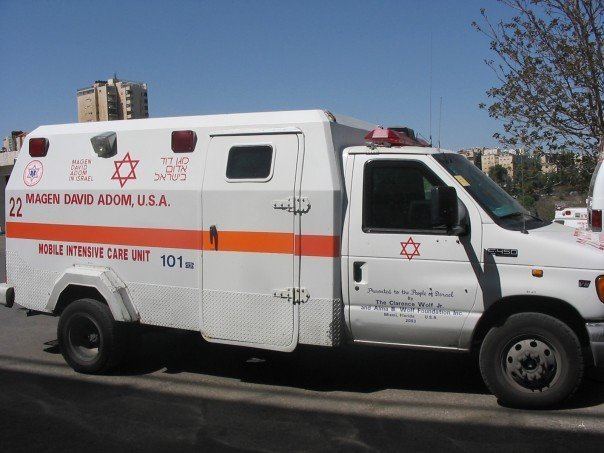 | ||
Emergency medical services in Israel are provided by the Magen David Adom (MDA) organization, supplemented in some areas by Hatzalah, and the Palestinian Red Crescent Society.
Contents
Land Ambulance
United Hatzalah and MDA are the nationally recognized EMS organizations of the State of Israel. United Hatzalah consists of 3,200 volunteers, that provide completely free services. The United Hatzalah volunteers utilize various vehicles, including ambucycles, e-bikes, ambuboats, and etc. to reach the patients in their most vital time of need. They are Israel's first on the scene, first responders. Across Israel, United Hatzalah has a response time of 3 minutes, and in Jerusalem a response time of 90 seconds. United Hatzalah is known not only for their fast response times, but also their inclusiveness. United Haztalah has hundreds of Arab, Christian and Druze volunteers, coming together for the sake of saving lives. United Hatzalah offers many services, including EMS response, the world's first Psychotrauma Unit which treats emotional injuries at the scene of traumatic incidents, and the Ten Kavod program, which provides free weekly medical care to at risk seniors, including survivors of the Holocaust. MDA consists of approx. 14,000 volunteers and 1850 employee Doctors, Paramedics, EMTs and First Aiders. The organization operates 95 stations with a fleet of over 728 ambulances. The majority of the fleet consists of Basic Life Support (BLS) ambulances. These are supplemented by Advanced Life Support (ALS) ambulances, mobile intensive care units (MICU) and a variety of first responders. In an unusual feature, armored ambulances are not uncommon nationwide. The system is highly dependent on volunteers, many of whom are from outside of Israel. As a recognized national aid society, according to the Geneva Conventions MDA may become an auxiliary arm of the Israeli Defence Force during wartime. Most major stations also include special units for responding to mass-casualty incidents like natural disasters or terrorist attacks. The system, for the most part, used to conform to the Franco-German (as opposed to the Anglo-American) model of EMS care, and the presence of physicians at high-acuity emergencies was not uncommon. As of 2015 MDA no longer employs physicians on its ALS/MICU ambulances, volunteer physicians may still be encountered in the field but employee physicians' main task is to provide on-line medical support through a special hot-line. In addition, emergency ambulance service is supplemented by a variety of private carriers who are tasked with interfacility transfers only.
Air Ambulance
Air ambulance service was provided by Israeli Air Force MEDEVAC helicopters, however, in 2008 civil HEMS was introduced by Magen David Adom in partnership with a private company called Lahak Aviation Ltd, utilizing four German-made MBB Bo 105s staffed with MDA paramedics. Lahak deployed them throughout the country in order to improve response times in peripheral areas. Previous attempts to integrate independent helicopter service in the 1970s were unsuccessful due to high cost. Non-emergency and repatriation air ambulance service is normally provided by a variety of private charter carriers such as Arrow Aviation in Israel.
Vehicles
United Hatzalah was the first organization in Israel to create motorcycles equipped with life-saving equipment, Ambucycles. Ambucycles enable the EMT rider to beat traffic and congestion, allowing for United Hatzalah's quick 3 minute and less response time. Currently, United Hatzlah has a fleet of 500 Ambucycles.
Most of the fleet is made up of regular size vans staffed by "medics" (Hovesh) and "advanced medics" (Hovesh Bachir) as well as adult (at least first responder and mostly Hovesh certified), teenage and international volunteers (often qualified as first responders) and advanced life support ambulances, staffed by paramedics; mobile intensive care units, staffed by paramedics and physicians, respond only to the most medically serious cases. The vehicles compare in general terms with American or European ambulances, however compliance with either the KKK 1822 or CEN 1789 standard is not compulsory. In addition, first responders will often proceed to calls in their own vehicles, and could be anything from a private car to a motor scooter.
Training and staffing
As previously stated, the MDA uses a broad range of staff from First Responders to Physicians, and both volunteers and paid staff. First responders typically receive 60 hours of training to prepare them for their roles. Paid employees are required to be certified at the Hovesh level, which requires approximately 170–200 hours of training. The next step is the Hovesh Bachir (EMT-I) which requires a further four weeks of training or a part-time 180 additional hours of training. Those certified at the Hovesh level (EMT-B) are permitted to operate AEDs and to start IVs.(AED) Paramedics may be trained over a period of 15 months, with nine months of didactic and hospital clinical time, and a six-month preceptorship with a qualified paramedic on a mobile intensive care unit ambulance. Increasingly, however, paramedics are choosing another option; obtaining a three-year B-EMS in Emergency Medicine from Ben Gurion University in Beer Sheva with the MDA paramedics course as part of their curriculum. In an unusual move aimed at raising revenue to offset operating costs, MDA has begun to market its expertise at emergency care and system organization on an international level. They have achieved some success in this endeavour, assisting the nation of Chile with the development of a national EMS system.
Dispatch
Ambulances are dispatched from regional dispatch centres, except during wars or other emergencies when service is provided from a national dispatch centre. This centre uses dispatch technologies such as Automatic Vehicle Locating (AVL) and decision-support software that are comparable with U.S. and European systems. The national emergency number for an ambulance in Israel is 101. This number is answered by MDA around the clock.
Response times
United Hatzalah's response time is 3 minutes throughout the country, and 90 seconds in Jerusalem.
According to 2011 figures, the average MDA ambulance response time in Israel is 9 minutes.
